 Jupiter Symbol |
 |
 Jupiter Symbol |
 |
As it should be, Jupiter was named after the king of the gods of mythology. It deserves this title because it is the largest of all of the planets. Its mass is about 318 times that of the Earth's. Its radius is about 11 times greater than the Earth's. In fact, Jupiter is massive enough that you could compare its mass to that of the Sun (it's about 1/1000 of the Sun's mass). If it were about 50-100 times more massive it could be a star (a really faint and dim star, but a star nonetheless).
Jupiter is usually one of the brighter objects in the night sky. Amongst the planets visible to the naked eye, it is usually second only to Venus in terms of brightness. With even a modest sized telescope you can see all sorts of details of Jupiter, including cloud features and its major moons. What is it really like? There have been several missions that have explored Jupiter and the other planets in the outer solar system. These include -
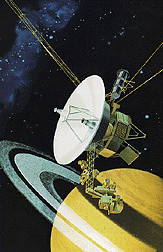 |
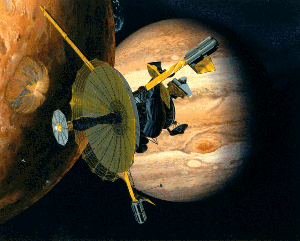 |
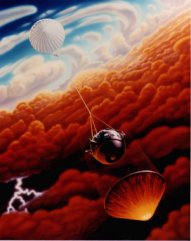 |
| Figure 1. The exploration of Jupiter has included visits by the Voyager spacecraft (two of them) seen on the left, the Galileo spacecraft (center) that was recently in orbit about Jupiter, and the Galileo spacecraft probe (right) that descended into the upper atmosphere of Jupiter. Images from NASA. | ||
If you were to look at Jupiter in a telescope, what would you see? Clouds, clouds, and clouds, but not all the same; in fact, the clouds come in various colors due to different chemical impurities in them. Also, the clouds are not all at the same levels in the atmosphere, so you are sometimes seeing deeper into the atmosphere in certain places. The horizontal cloud features are divided into two groups, the belts and zones. The belts are the darker and deeper parts of the atmosphere, while the zones are the lighter and higher elevation regions. The belts and zones get their coloring from different chemicals - the light colored zones have ammonia ice crystals in them, while the dark belts have ammonium hydrosulfide crystals. The zones look white and the belts look brown. There is also another cloud layer below the belts, one made of mainly water ice crystals, and above all these layers is one of haze. While the colors of the clouds are due to these various chemicals, the atmosphere is made mainly of hydrogen and helium, which is also what most of the planet is made of.
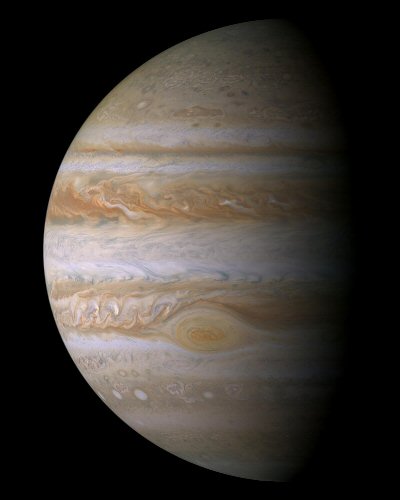 Figure 2. The
belts and zones of the jovian atmosphere are apparent in this image of
Jupiter taken by the Cassini spacecraft. Image credit: NASA.
Figure 2. The
belts and zones of the jovian atmosphere are apparent in this image of
Jupiter taken by the Cassini spacecraft. Image credit: NASA.
When the Galileo probe went into the atmosphere of Jupiter it discovered some very interesting things that were a bit of a surprise.
It appears that we have more questions to figure out about Jupiter than we started with.
One feature that affects how the clouds of Jupiter appear to us is the rate of its rotation. In fact, Jupiter is the fastest rotator (spinner) in the solar system! Think about that - an object much larger than the Earth spinning around about two times faster - very dizzy! It only takes about 10 hours for Jupiter to rotate once. It is not a solid object, so the rotation is different at different latitudes. The equator rotates the fastest; the poles go the slowest. This variation in rotation, or differential rotation, we've already seen in the Sun, and it is also present in the other jovian planets. There are some consequences for spinning very fast and having differential rotation. One is that the planet doesn't stay very spherical but gets a little squished, so that the diameter of the planet measured from pole to pole is less than the diameter measured at the equator. Basically, Jupiter is wider and shorter than a perfect sphere.
Another side effect of the fast rotation rate are the complex weather patterns. If you look at the cloud patterns of Venus (1 rotation = 243 days), the cloud circulation patterns are very long, stretching from pole to pole. For the Earth (1 rotation = 24 hours), there are complex wind patterns such that some latitudes have the winds toward the east and others toward the west. With Jupiter, this effect is even more extreme, with many more regions (latitudes) having winds going one way and many others going the other way. One part of the atmosphere is moving slightly faster or slower than an adjacent part or even going in the opposite direction, so this will produce some rather interesting effects. The shearing winds and turbulence in the atmosphere lead to the formation of circulation regions, or spots (storms). One thing that has been seen over time is the disappearance and reappearance of some of the major belts. This happened recently in 2010. For this reason, astronomers continue to observe Jupiter to help understand why the features do change over time.
The largest of these storms is the Great Red Spot. This spot is so large that you could fit two or three Earths inside it, depending on its size (it's a storm, so it can get bigger or smaller over time). The Great Red Spot has been observed for about 300 years, but it is probably much older (you can't see it without a telescope, so it wasn't discovered until the telescope was invented). It also tends to tear up smaller storms that get too close or just basically gobble them up completely. There are also other spots, which appear as white, brown and red features, though they don't appear to be as long lived as the Great Red Spot. In 1998 and 2000 several spots merged together to form a larger spot, which again merged with other spots in 2005 to create what is called Red Junior, a spot that is pretty good sized - not as big as the Great Red Spot, but one that is holding up. Red Junior passed near the Great Red Spot in the summer of 2006 and seems to have survived the passage quite well. Another spot also popped up in 2008, but it doesn't have a cute name yet. We'll have to watch and see how things develop in the future with these spots. The image that is at the link given above is a false color, near-infrared image, which is why the spots don't actually look red. Such images show the temperature variations within the atmosphere and help astronomers determine the elevation of the various features as well as the temperature and composition structure of the jovian planets. In 2014 astronomers started noticing that the size of the Great Red Spot was at an all-time low, a bit less than 17,000 km wide. Back in 1800's it was about 41,000 km wide, so that's quite a bit smaller. It is possible that smaller storms are influencing the Great Red Spot can altering the internal dynamics of the storm. We'll have to keep watching it to see what happens next.
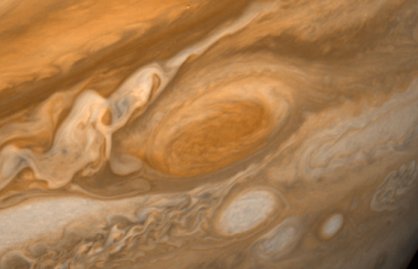 Figure
3. Click on the image to see an animation of the motion of the Great
Red Spot. Images from NASA.
Figure
3. Click on the image to see an animation of the motion of the Great
Red Spot. Images from NASA.
Both the Voyager and Galileo spacecrafts have been able to see the dark side of Jupiter and observe things that aren't visible from the Earth. This includes lightning that is seen in the cloud layers. Also, it is possible to see aurorae near the poles (this can be seen either on the dark side of the planet or using UV telescopes from the Earth). What is causing these features? It is thought that they are produced by charged particles in the atmosphere, which interact with the magnetic field. This also indicates that the magnetic field is very strong. Previously I mentioned that it was large (about 30 million km wide), and it is about 19,000 times stronger than the Earth's magnetic field.
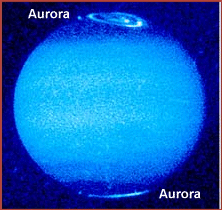 Figure
4. The aurorae of Jupiter as
seen by the Hubble Space Telescope using its UV camera. Image Credit: J.
Clarke and G Ballester (University of Michigan), J. Trauger and R.
Evans (Jet Propulsion Laboratory) and NASA.
Figure
4. The aurorae of Jupiter as
seen by the Hubble Space Telescope using its UV camera. Image Credit: J.
Clarke and G Ballester (University of Michigan), J. Trauger and R.
Evans (Jet Propulsion Laboratory) and NASA.
What produces the magnetic field? To answer that we need to look at the internal structure of the planet. At the center is a small core of rock and metal - this core would be about the same size as the entire Earth, though much more massive. Above that is a large layer of liquid metallic hydrogen. Above that, there is a layer of mainly liquid hydrogen. Above that layer is a layer of molecular hydrogen, and at the very top are the atmospheric layers that are visible to us - water ice crystals, ammonium hydrosulfide, ammonia and haze at the very top. The internal structure is shown in Figure 5. As mentioned previously, the composition of Jupiter is thought to be very similar to the Sun, so there is also a significant amount of helium in these layers as well. The helium isn't so important here - it is the hydrogen that we should pay attention to.
Now that you know what the interior is made up of, can you figure out what is producing the magnetic field? Do you remember what you need in order to produce a strong magnetic field? You need two things - fast rotation and an electrically conducting layer. Jupiter certainly has a good rotation rate (more than two times as fast as the Earth), so what about the electrically conducting layer? There is that pretty large layer of liquid metallic hydrogen in there. As was stated in Terminator 2 - "it is liquid metal." While it isn't iron or nickel, it does have some of the same properties as these metals, and it can conduct electricity. This layer is so large that it helps give Jupiter the very strong magnetic field that it has.
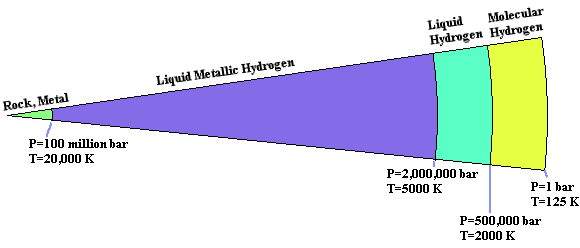 Figure 5. The internal structure of Jupiter is
shown. The main element is hydrogen, but it is found in various forms
inside of Jupiter. Starting at the layer where the pressure equals the
Earth's atmospheric pressure, the first interior layer is mainly
hydrogen gas in molecular form (H2). At about a depth of 7000
km the hydrogen is under so much pressure that it is in a liquid form.
After another 7000 km, you run into the layer of liquid metallic
hydrogen. The core of rock and metal only extends about 10% of the way
from the center, so it has a radius similar to the Earth's but is about
10 times more massive than the Earth.
Figure 5. The internal structure of Jupiter is
shown. The main element is hydrogen, but it is found in various forms
inside of Jupiter. Starting at the layer where the pressure equals the
Earth's atmospheric pressure, the first interior layer is mainly
hydrogen gas in molecular form (H2). At about a depth of 7000
km the hydrogen is under so much pressure that it is in a liquid form.
After another 7000 km, you run into the layer of liquid metallic
hydrogen. The core of rock and metal only extends about 10% of the way
from the center, so it has a radius similar to the Earth's but is about
10 times more massive than the Earth.
If you were to go out to Jupiter and measure the amount of energy (heat) that you would be getting from Jupiter and compare that to the energy that you would be getting from the Sun, you would note that Jupiter is radiating more heat, about two times as much. Why is Jupiter hot? Actually, it has never been cool. This is heat left over from the formation of the planet. There is so much mass that it will take a long time for it to completely cool off. This is also something that helps keep the atmosphere active. The heat coming from the center helps in the circulation of gases, including the rising and sinking motions seen in the zones (rising) and belts (sinking).
Another surprising discovery was that of a very thin ring observed by the Voyager spacecraft. The ring is rather small and composed of dark, dusty particles, so it cannot be seen from the Earth. The best way to view such rings is to let sunshine highlight them, sort of the same way that you can see dust particles in the air if there is sunshine or another bright light shining through them. As you will see, all of the Jovian planets have at least one ring. A recent image of the ring obtained by the New Horizons spacecraft can be seen here.
I really hate this discussion of the jovian planets, since the numbers keep changing. It seems that every few months someone discovers a bunch of new satellites (moons) around a jovian planet, so I have to keep updating my notes - very annoying! Currently, there are more than 60 known satellites around Jupiter, which makes it the champion in terms of "most moons." I'm not going to give an exact number, since if I do, someone will come along and discover a couple more, and I'll have to change my notes again. It is not unusual for the jovian worlds to have so many moons; they all have quite a few satellites. In a way, they seem to be mini-solar systems with a variety of worlds around them. There are three categories of satellites. First, there are the really puny ones, ranging from 1 to 300 km in diameter. These tend to be pretty common and also rather irregular in shape. They are also prone to have retrograde (backwards) orbits. The next batch has a range of sizes between 300 and 1500 km. The really big ones are more than 1500 km in diameter, similar in size to our Moon. Most of the satellites for the jovian planets are in the "puny" category, with only a few in the really big group. It is thought that many of the puny satellites are actually asteroids that the planets have captured. These are also the most likely satellites to have unusual orbits or shapes (non spherical shapes). We will be looking only at the big ones for the most part.
The jovian planets are located far from the Sun, so their satellites tend to be made of common materials found at these distances. These include a large amount of ice in various forms, including not only water ice but also CO2 ice, methane ice and ammonia ice. There is also some rock and metal, but it is generally much rarer at this distance from the Sun. Remember, low density material was a much more common commodity in the early solar system, especially far from the Sun.
The names of the satellites come from mythology and are named after people that Jupiter was associated with, in some cases in a rather, ahem, "inappropriate manner," especially for a married deity (which, of course, did not make his wife happy). Obviously, he was a rather busy fellow. Not all of the satellites have been officially named - those that were recently discovered get numbers assigned to them before they get their official names.
The four big satellites around Jupiter were first seen by Galileo (the guy, not the spacecraft) when he turned his telescope to the sky in 1610. They are collectively known as the Galilean Satellites.

Figure 6. The four Galilean satellites. Furthest to the left
is Io, followed by Europa, next is Ganymede and finally Callisto. The
satellites are shown to scale. Images from NASA.
The physical characteristics of the Galilean satellites vary with increasing distance from the planet. The one closest to the planet is Io, which has the highest density of the four. It is composed mainly of rock, probably with layers of magma in the interior (molten rock). Another interesting feature is that Io has virtually no impact features, indicating that it has a very young surface. The next satellite out is Europa, which is less dense, has less rock and more ice in it, and more impact craters and thus a slightly older surface. Next is Ganymede, which has a lower density, less rock and more ice, and more craters. Finally, there is Callisto, with the lowest density, the most ice, and the most impact features. Of the Galilean satellites only Europa is smaller than our own Moon. You can think of these as mini-planets. The images in this section are from Calvin J. Hamilton.
Io looks very different in appearance from any other object in the solar system. Nothing comes anywhere close to looking like this thing. When the Voyager images from this object were first seen, someone mentioned that it looked like a pizza. The scientists knew that there was something strange about Io, since they noted a great deal of sulfur in the area of Io's orbit. They weren't quite sure why the sulfur was there. Basically, Io is covered with volcanoes, which were discovered by the Voyager spacecraft. Currently, there are mainly sulfur and sulfur compounds given off by these volcanoes. Why are there no other gases? Don't volcanoes give off other gases? The low weights of the other gases, such as CO2 and H2O, would allow them to easily escape from the satellite, while the heavier sulfur falls back to the surface. The sulfur gets recycled over and over, since the volcanoes are continually active. Click here to see images of the eruptions.
If you go to the surface of Io, you would find sulfur in liquid, solid, frost and gas forms. It is a pretty stinky place. Eight volcanoes were seen erupting during the relatively quick Voyager fly-by. About 100,000 tons of material are expelled every second at a velocity of about 1 km/s. There is so much activity on Io that large scale variations in its surface features can be seen in only a few years. If you added up all of the lava that comes out of Earth's volcanoes over 100 years, then you'd have the amount of material blasted out of Io's volcanoes in 1 year.
What is Io's problem? Io is getting heated by the gravitational pull that it gets from Jupiter and the other moons. Very strong tidal forces are basically pulling and tugging the planet back and forth - remember, the other satellites are pretty big and therefore have a good deal of pull on Io as well. This explains why there are no impact craters on the surface. The continual volcanism will cover up any craters that would appear. Also, the Galileo spacecraft was able to detect a magnetic field around Io. To produce the magnetic field seen by Galileo, Io would need a very large iron core, one that would extend over 1/2 the radius of Io!
Europa - Europa, like Io, is also a rather unique place. It is ice covered (which isn't so unusual), but it has very few craters; only tiny ones are seen and there aren't very many of those. Why? Like Io, Europa is heated by the tidal pulls of Jupiter and the other moons, but since it is further from Jupiter than Io, it doesn't get as hot. However, it is hot enough for the ice to easily flow over the surface and cover up most distortions (craters). Europa is the smoothest place in the solar system, with very few craters. Recent observations by the Hubble Space Telescope indicate that water vapor is erupting from the surface, sort of like a geyser. This indicates that there is internal heating keeping the ice relatively flexible. Also in some cases the ice moves like the crust of the Earth, with subduction zones where one ice sheet is forced under another one. But what's under the ice?
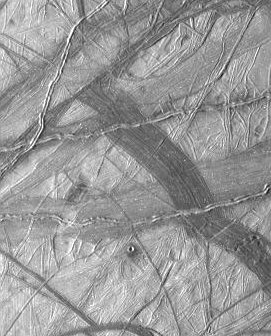 Figure 9. The ice cracks on the surface of Europa.
Notice how the cracks are made up of several parallel groves. These
indicate a freezing, melting, and cracking cycle that allows the cracks
to get filled up time and time again.
Figure 9. The ice cracks on the surface of Europa.
Notice how the cracks are made up of several parallel groves. These
indicate a freezing, melting, and cracking cycle that allows the cracks
to get filled up time and time again.
One of the more intriguing aspects of Europa is what is under the icy crust. Based upon the amount of heating it gets and its composition, there could be a thick liquid water ocean under the ice layer. Europa is considered a likely location where life could exist in the solar system due to the presence of liquid water as well as internal heating. Of course, we would have to go there and find it before we could be sure.
Ganymede - There are many more craters on this world, but there are also many ice flow features (similar to what was seen on Europa). This is a bit confusing, since Ganymede is so much further away from Jupiter than Io and Europa. It is possible that due to its large mass there is a great deal of internal heating from radioactive decay (Ganymede is the largest satellite in the solar system). There should also be some tidal heating from Jupiter but nowhere near the amounts that Io and Europa experience. Data from the Galileo spacecraft indicate that about 1/2 of the surface has been resurfaced by ice flows or ice tectonic (volcanic) activity. The Galileo spacecraft has detected a magnetic field around Ganymede. What produces it? We're not entirely sure, since Ganymede is less dense than the other two satellites mentioned (remember, density decreases as you get further from Jupiter). It is possible that there is a small iron core. A large amount of radioactive material trapped in the interior there early in the history of the planet could help to explain the ice flow features on Ganymede.
There is debate about what is below the surface of Ganymede. Early models hinted that there could be a liquid ocean of slushy ice or even water below the solid ice, similar to Europa. A recent model indicates that a multi-layered ice and water ocean could be below the surface. In either case it does seem that there is a good chance for water in a liquid form to exist below the surface, so this world is also quite intriguing.
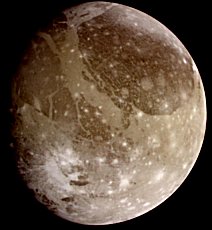 |
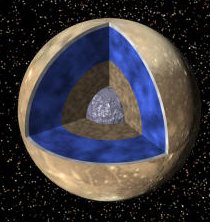 |
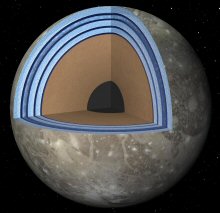 |
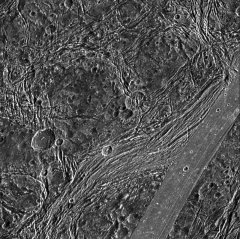 |
| Figure 10. (far left) The surface of Ganymede is shown. (center left) A view of the interior of Ganymede shows one of the possible models for the interior - a small iron-nickel core (gray), covered with a rocky layer (brown) and a layer of soft ice or water(bluish). This is all under the rigid, visible ice layer of the surface. (center right) Another model of the interior with multiple layers/shells of ice below the surface, a liquid water between them. (far right) An up close view of the surface showing the ice flow features along with some cratering. Images and artwork from NASA/JPL-Caltech. | |||
Callisto - This place is much
more typical of the type of surface that is seen in the outer solar
system. There are many craters, including some really big ones. This is
what you would expect since there are fewer tidal forces and less tidal
heating due to its greater distance from Jupiter. One surprising result
from the Galileo spacecraft is
the possible presence of a thin, salty ocean under the icy surface. This
idea is based upon the way that the magnetic field of Callisto seems to
change over time. The surface is much older than the surfaces of the
other satellites. Some of the really big impacts could date from the
early days of the solar system. The surface is icy, so the large impact
features tend to have a rippled look to them, like the effect of
dropping a rock in the water. It isn't liquid water, but the ice is
elastic enough to show ripples.
As mentioned previously, there are more than 60 known satellites
around Jupiter, and you can see a list of them by going
here. Some of the names may be familiar to you if you read any
stories from classical mythology, but some names are rather
obscure - and hard to pronounce. Except for the I
four I discussed above, the rest of these are tiny and not really too
exciting.
 Saturn Symbol |
 |
In terms of mythology, Saturn was the father of Jupiter (he was also called Cronus). Saturn is the last of the planets that have been known since ancient times and the most distant planet that can be seen easily with the eye. In most respects Saturn is very similar to Jupiter. They have similar compositions and internal structures, so most of the items mentioned about Jupiter can be directly applied to Saturn. There are some important differences, though.
While Saturn has a radius that is about the same as Jupiter's (though a little smaller), it has only about 1/3 the mass of Jupiter. This gives Saturn a much lower density (less material filling the same volume of space makes it rather fluffy). In fact, Saturn has the lowest average density of all of the planets. You may have seen cartoons in elementary school science books showing Saturn sitting in a bathtub of water, not because it needs to wash behind its ears, but because the average density is less than that of water, and in that sense it could float in water. That is the average density. There are, of course, parts of Saturn that have much greater densities than water and parts with much lower densities. The bathtub depiction of Saturn is not quite right (oh, dear, another childhood illusion destroyed - just don't ask me about Santa Claus).
Another side effect of Saturn having a lower mass than Jupiter is that it has a lower surface gravity. This causes the clouds layers to be spread out over a larger range. The cloud layers stretch to greater depths than they do on Jupiter, so the cloud features are less distinct. Saturn has the same cloud layers (ammonia, ammonium hydrosulfide and water ice), but they get sort of fuzzed out of view by the haze layer on the top. Even though the clouds have the same compositions as those on Jupiter, they are not as prominent, so its storms and spots aren't as obvious as Jupiter's. There are times when the storms do become pronounced, as was the case of a storm that started in December 2010, which was going strong into 2011. This image from the Cassini spacecraft shows the 2010-2011 storm.
Saturn also has a slightly slower rotation rate than Jupiter, but it
is still going fast and has differential
rotation just like Jupiter, so there are some spots and storms,
though they aren't as easy to see. Also, due to the lower amount of mass
and its slower rotation rate, it has a weaker magnetic field (it's only 1000 times stronger than the
Earth's). The effects of the magnetic field are visible, though. Aurorae
can be seen near the magnetic poles, just like on Jupiter. If you would
like to see a movie showing the motion of the aurora, just click
here.
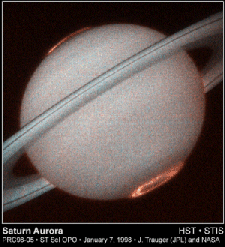 |
Figure 12. To the left is an image of the aurorae visible in the atmosphere of Saturn. This is an image from the Hubble Space Telescope (UV image). The image to the right is also from the Hubble; this one shows one of the rare large storms in Saturn's atmosphere. This storm did not last very long and was gone in a few months. Image credits: J.T. Trauger (Jet Propulsion Laboratory), Reta Beebe (New Mexico State University), D. Gilmore, L. Bergeron (STScI), and NASA. | 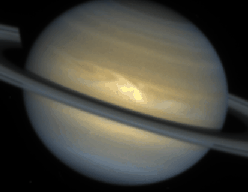 |
While the planet itself doesn't look so spectacular, it makes up for this by having an extensive ring system. Actually, Saturn's ring system totally kicks a... well, you know what I mean. These rings are so impressive that Galileo sort of saw them with his tiny telescope. A weird thing happened after people read about Galileo's discoveries a few years later. When others tried to observe the rings at this time, they could not see them! Why? Saturn is tilted on its axis so that the orientation of the rings changes over time. There are times, about every 16 years, when the rings are tilted edge on with respect to the Earth so that they are virtually invisible.
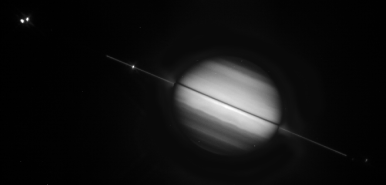 Figure 13.Saturn's rings are not visible in this
view from August 1995, when the tilt of the planet (and the rings) was
such that they were virtually invisible from the Earth. Some of Saturn's
satellites are visible, though. Image credit: Phil Nicholson (Cornell
University) and NASA.
Figure 13.Saturn's rings are not visible in this
view from August 1995, when the tilt of the planet (and the rings) was
such that they were virtually invisible from the Earth. Some of Saturn's
satellites are visible, though. Image credit: Phil Nicholson (Cornell
University) and NASA.
The rings are very thin but very spread out (a few tens of meters thick and about 270,000 km wide). When they are edge-on, they are very difficult to see. However, this is a great time to see the satellites and to look for undiscovered ones. This sort of alignment doesn't happen very often, so you will usually be able to see the rings to some degree when you look at Saturn through a telescope.
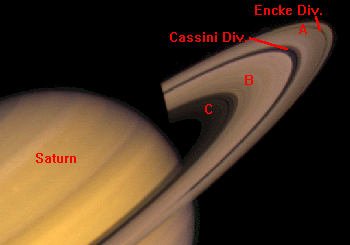 From the Earth we can see the
following rings - A, B, and C. (This and other ring images from
NASA). The A-ring is the outermost, while the B and C rings are closer
to Saturn. While there is an obvious gap between the A and B rings, the
way you distinguish the B and C rings is by how they look. The C ring is
sort of thinner or more transparent looking than the B ring. As
mentioned, there are gaps in the rings. The two gaps in the rings that
are visible from the Earth are the Cassini division
and the Encke division. The
Cassini division (between the A and B rings) is easily seen, but you
would need a very powerful telescope to see the Encke division. The
Encke division is actually contained within the A ring. Even though the
divisions look rather dark, there is stuff in them, as you'll see.
From the Earth we can see the
following rings - A, B, and C. (This and other ring images from
NASA). The A-ring is the outermost, while the B and C rings are closer
to Saturn. While there is an obvious gap between the A and B rings, the
way you distinguish the B and C rings is by how they look. The C ring is
sort of thinner or more transparent looking than the B ring. As
mentioned, there are gaps in the rings. The two gaps in the rings that
are visible from the Earth are the Cassini division
and the Encke division. The
Cassini division (between the A and B rings) is easily seen, but you
would need a very powerful telescope to see the Encke division. The
Encke division is actually contained within the A ring. Even though the
divisions look rather dark, there is stuff in them, as you'll see.
To understand what Saturn is really like you must explore it, and, of course, there have been several spacecraft fly-bys of the Saturnian system. The Pioneer 11 (1979) and the two Voyager spacecraft (1980, 1981) flew by after they visited Jupiter and got better pictures of the rings. Also, by going behind the planet on the dark side, they had a better view of the rings. Images of the rings showed that there weren't just a few rings but hundreds of them, each only a few kilometers wide. You could almost think of the rings as the grooves on a phonograph record. The Voyager spacecraft discovered several more rings as well, so now there are the D, E, F, and G rings. All of these new rings except for the E ring are pretty small - the E ring is wide but very sparse. In 2006, the Cassini spacecraft had discovered another ring, which will no doubt be the H ring. The only problem with all of these rings is that they are arranged out of order when you go from the planet outwards. Again, with new technology comes new discoveries, and things can get a bit messed up with such discoveries. Just click here to see the rings and their relative locations to the satellites orbits.
Right now the Cassini spacecraft is in orbit around Saturn, just like the Galileo spacecraft was in orbit around Jupiter. It got to the Saturnian system in the Summer of 2004, and has already made several discoveries, including another ring (not yet named) and some new moons (possibly). The Cassini spacecraft also had a probe. which was named Huygens, not into Saturn, but onto the surface of the satellite Titan (more about this below). Obviously I'm going to have to keep updating my notes with this spacecraft making many more discoveries - that's just part of the job.

The rings, especially the thin outer ones, are kept in tidy order by Shepherd Satellites. These are small satellites that are found near thin ring sections that use their gravitational pull to keep the particles in the rings in their places. Actually, most of the ring structure can be related to the various satellites of Saturn, either as sources for ring material or as objects that influence the ring structures. Various gaps and inward/outward motions of the rings are related to the motions of other, larger satellites that move the ring particles around slightly. Click here to see an image showing how the same section of the rings appears at different locations around the planet.
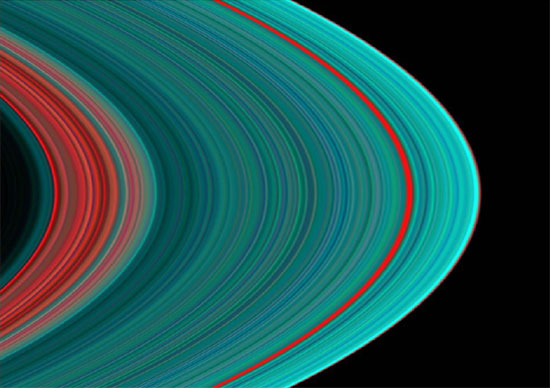 Figure
14. A false color image from the Cassini spacecraft of the A ring of
Saturn. This shows the individual rings that make up the larger ring
structure and also the material that is found in the dark appearing
Cassini and Encke divisions. The Cassini division is on the left side of the
image and is colored redish, while the Encke division is much narrower, towards
the right side, and is a darker red.
Figure
14. A false color image from the Cassini spacecraft of the A ring of
Saturn. This shows the individual rings that make up the larger ring
structure and also the material that is found in the dark appearing
Cassini and Encke divisions. The Cassini division is on the left side of the
image and is colored redish, while the Encke division is much narrower, towards
the right side, and is a darker red.
As mentioned previously, the divisions were found to not be completely empty. They appear to be dark and empty when viewed from the Earth, but when looked at from behind the planet with the sunlight shining through them, they appear to have particles in them. Such particles are generally rich in dark material like dust, so they only show up well when light shines through them, just like the dark, dusty ring around Jupiter. Most of the major ring sections are made up of particles that have more ice in them, so they reflect light better and show up more easily. The particles in the rings can be as small as dust specks and as large as houses.
Where did the rings come from? When in doubt, blame gravity. In this case, gravity is guilty of the crime. It has to do with a gravitational boundary around a planet known as the Roche Limit. Objects that are a certain distance from the planet (within the Roche Limit) can be easily broken up if they are not made of very strong material. Chunks of lightweight stuff like ices are very easily broken apart. These objects will continue to break up until the particles are too small to break apart.
Why should they break up? It can be related to Kepler's 3rd law. If you don't remember this one, I'll remind you. It says that the closer you are to an object, the smaller your orbital period (the faster you go). If you have a big chunk of material that gets into the Roche limit, the part of the object that is closest to the planet will want to move faster as it orbits around, while a part that is further away will want to move more slowly. The differences in speed will cause the chunk of material to break apart. The material will keep breaking apart until the speed difference across the object is not significant enough to tear it apart anymore.
Any icy object, like a moon or a comet, cannot remain as a large solid if it is too close to the planet. This helps to explain why the massive jovian planets all have rings, since they have large Roche limits (since they have large masses).
In 2009 the Spitzer telescope discovered a rather unusual ring around Saturn. This ring is much further away than the others and it is tilted significantly relative to the other rings. It is also rather spread out, stretching from 6 - 12 million km from Saturn. And in case you were wondering, rings are common even beyond our solar system. Here is a news article about a ring system about a large planet that makes Saturn's ring system rather puny by comparison.
Saturn has a large number of satellites (62 as of August 2011), and there are more objects that are suspected satellites, but they have yet to be confirmed. It is sort of difficult to find a satellite around Saturn because the rings are so bright they tend to outshine any objects near them. When the rings are tilted so that they appear to be gone, astronomers will try to find new moons around Saturn. Most of the satellites are pretty standard for the outer solar system - icy, low density, small worlds. Of course, there are a few exceptions.
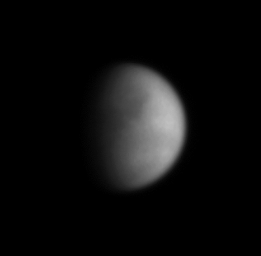 IR images from the Cassini spacecraft showing the surface features
on Titan. Image from NASA/JPL/Space Science Institute.
IR images from the Cassini spacecraft showing the surface features
on Titan. Image from NASA/JPL/Space Science Institute.
Titan (click on it to see an IR movie of Titan's surface based upon Hubble Telescope infrared images). Titan is a very large satellite; it's even bigger than Mercury. This isn't why it's important. Titan has a thick atmosphere! The atmospheric pressure is about 1.6 times the pressure on the Earth's. Unlike Venus or Mars, the atmosphere isn't too thick or too thin compared to the Earth's. The composition of the atmosphere is also mainly nitrogen (again, just like the Earth). There is also other stuff like methane and ethane just to make it annoying and stinky. The atmosphere contains a haze layer that prevents us from easily seeing the surface. The Cassini spacecraft has been able to give us a view of the surface though, using an infrared imaging camera.
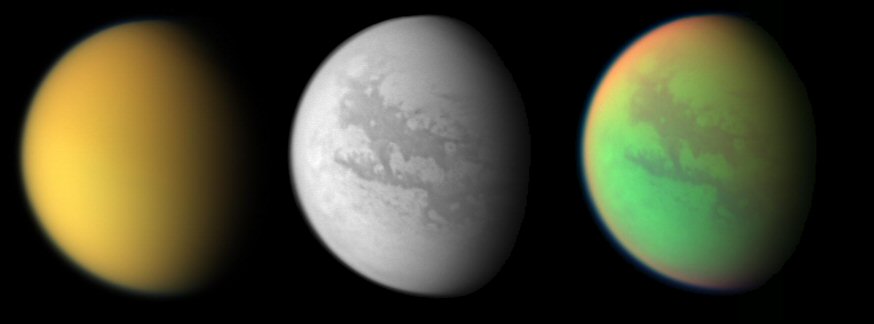 |
|
| Figure 15. Images of Titan from Cassini. Above are three views of Titan. The first, a visible light image, the second, an infrared image, and the third, a false-color infrared image. In the false-color image, the red areas actually do correspond to layers in the atmosphere where methane absorbs sunlight, and green areas are surface layers that are visible. To the right is another infrared image obtained by Cassini. Due to the haze layer on Titan, the only way to see surface features is to use other than visible wavelengths. Images from NASA/JPL/Space Science Institute | 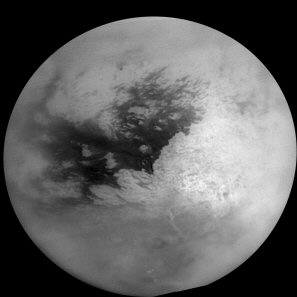 |
Is Titan really just like the Earth? No, it is much further from the Sun, so it gets pretty cold. The temperature is close to 95 K (-290 degrees F), so that makes it rather unpleasant for humans. The really freaky thing about Titan is that the temperature and the pressure at its surface are such that methane can exist as a gas, solid or liquid there, sort of the same way that water can exist on the Earth. But there has been quite a bit of speculation about Titan as a place for "different" forms of life - those that may use methane rather than water as a basis. This is still just guess work at this time, but it is does keep our interest rather high for this little world.
Due the presence of the atmosphere, Titan was the target for the probe (named Huygens) that the Cassini spacecraft dropped off. The probe floated through the atmosphere for a few hours and then landed on the surface and transmitted data for about 1 hour. To see a movie of what the probe "saw" as it descended, just click here - it does get a bit dizzy as it goes down, but of course it was pretty windy there. It was able to make a thorough analysis of the clouds, atmosphere and some surface features. Amongst the more interesting things that have been discovered by the Cassini mission are -
The other moons can be divided into the usual categories of really puny and sort of in between sized. The really small ones tend to be the ones found around the rings (they tend to be shepherd satellites). All of the moons except for Enceladus show considerable cratering.
Enceladus has some ice flow features and some rather unusual surface features. Apart from Titan, it is the most interesting world around Saturn. This is due in part to the fact that it has a large amount of resurfacing going on, just like on Europa and Ganymede. And what could cause that? Again, the best cause would be internal heating, similar to the heating of the Galilean satellites. Recent calculations of the amount of tidal heating indicate that the cracks (as seen in the images below) may actually open and close while Enceladus orbits around Saturn once every 1.3 days. Another item to support the heating was the existence of an atmosphere around Enceladus, something that Cassini also discovered. This was a surprise, since Enceladus is rather small to hold onto an atmosphere. The atmosphere is made primarily of water vapor with some nitrogen, carbon dioxide and other carbon-based molecules mixed in.
Another recent discovery were active geysers erupting from the surface of Enceladus. A recent tally found 101 distinct geysers on the surface! Observations of the material indicates that it is mainly water vapor, with some carbon dioxide, carbon monoxide and some organic compounds. The presence of water vapor indicates that there are likely pools of liquid water just under the surface of Enceladus! In 2009 the Cassini spacecraft discovered ammonia in the vapor of Enceldus, which provides even more evidence that water may exist as a liquid below the surface. How does the presence of ammonia tell us about liquid water? Ammonia acts as a natural "anti-freeze" and will allow water to stay in a liquid state even at the extremely low temperatures on Enceladus. The eruptions from Enceladus also appear to be the source for the moon's atmosphere as well as a major contributor to one of Saturn's rings. A simple measurement of the surface temperature shows that the cracks on Enceladus are significantly hotter than the surrounding areas, again, showing that Enceladus is currently hot and active. Enceladus is located right in the middle of one of the outer, fainter rings (the "E" ring), and if it is blowing a bunch of material off of its surface, this material would likely end up in orbit around Saturn as part of the ring system. The Cassini spacecraft has also detected grains of salt in the "E" ring around Saturn, along with the regular ice particles. If this ring is produced by Enceladus' eruptions, then the salt is another indicator of a liquid interior for the moon - the evidence just keeps on piling up!
In 2011 it was determined that the water vapor not only contributes to the ring around Saturn, but some of it can actually get to Saturn itself! This is an important discovery since it shows that material can go from the satellite and get into the upper layers of Saturn's atmosphere. It is fairly rare for there to be a transfer of material observed from one object to another, but with so much water being blasted out (current estimated rate of water expulsion is 250 kg/sec), some of it can travel down to Saturn. Astronomers have also determined that the eruptions seem to be linked to the orbit of Enceladus around Saturn, with more activity when the moon was far from Saturn. It is thought that when it is close, the gravitation effects of Saturn tighten up the cracks and prevent the fissures from erupting, while when it is far from Saturn, there is less gravitational contractions and the material can erupt more freely.
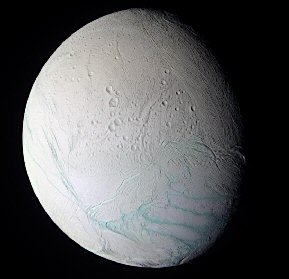 |
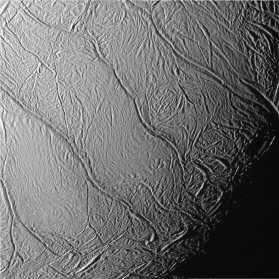 |
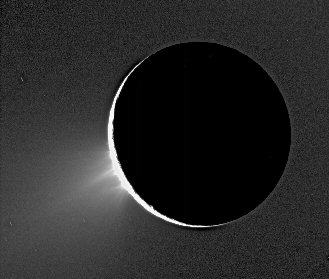 |
| Figure 17. Images of Enceladus. On the left is
the view from Cassini, with Saturn in the background. Note the rather cracked
surface and the relatively few craters. A close up view is seen in the middle
showing the flow features, nicknamed the "tiger strips".
On the right is a view of an eruption of material from the surface.
Images from NASA/JPL/Space Science Institute.
While Enceladus has the most dramatic geyser activity, it appears that a couple of other satellites are also geologically active. In 2007, evidence of eruptions were linked to Tethys and Dione, two relatively moderate sized objects. But of course with further studies we might find even more activity in the Saturn system, courtesy of the Cassini spacecraft. The named satellites were given names related to the Titans of mythology, but now there are so many that some other mythologies are included, such as Norse and Inuit. Some of the names are possibly familiar to you - Pan, Daphnis, Atlas, Prometheus, Pandora, Epimetheus, Janus, Mimas, Methone, Pallene, Enceladus, Tethys, Telesto, Calypso, Dione, Helene, Polydeuces, Rhea, Titan, Hyperion, Iapetus, Kiviuq, Ijiraq, Phoebe, Paaliaq, Skathi, Albiorix, Bebhionn, Erriapo, Siarnaq, Skoll, Tarvos, Hyrrokkin, Mundilfari, Narvi, Bergelmir, Suttungr, Hati, Bestla, Farbauti, Thrymr, Aegir, Kari, Fenrir, Surtur, Ymir, Loge, Fornjot and about nine more that have yet to be named. Images from NASA/JPL/Space Science Institute and Calvin J. Hamilton.
Recently the Hubble Space Telescope was able to record a movie showing the motion of several
of moons in front of Saturn. It does look rather
nifty.
Now that you've read this section, you should be able to answer these questions....
| ||